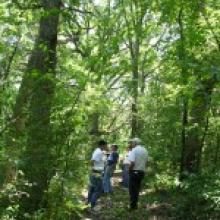This is a busy time of year around our offices as our Learn About Your Classes have started, in 23 locations and on the web. One of our topics is planning for your forest, so I thought I would take some time today to share some insights with you. I was reading a couple of resources in preparation for my talk, and came across a good entry. The topic was “Why people don’t manage…and why they should”.Several reasons were mentioned: “I hunt, and am not interested in the trees”, “we just want a place to retire”, “I don’t want my land damaged by a logger”, and “I don’t know what to do”.
For one, wildlife and forests are intimately connected. If you want to hunt for grouse (same can be said about wildlife watching), you need to manage for grouse habitat. Second, who wouldn’t want a little extra income in retirement, and it’s a great time to learn to play in your woods. Third, some of the healthiest forests are well managed forests; it is about finding some good professionals committed to forest stewardship. And as to the fourth one, well, that is what the rest of this article is for.
When it comes to management planning, I highly recommend putting pen to paper. However, a plan doesn’t have to be a 35 page novel. I’ll share what a management plan would ideally include, but it could be as simple as a vision and a timeline of some activities you want to do. A management plan is essentially a road map for the future direction of your property and how you want to use it. When a professional forester writes a forest management plan, they will likely include:
- A goal statement and objectives for the property
- Maps and aerial photos of the property
- Descriptions of various forest stands on the property and recommended activities
- A timeline of all the suggested forestry activities
- A historical description and any heritage resources
- An update on forest health and potential threats (insects, diseases, invasives)
There is a lot of work that needs to be done before a final plan can be written though. A good place to start is thinking about, and exploring your woodlands. Get out that pen and paper and start writing. When did you acquire the land? What was it used for before you acquired it? Why did you (or your family) buy the land? How do you currently use the land? What interests do you have (e.g. wildlife, scenery, hiking, hunting, fishing, firewood, income, other recreation, wild flowers, family time, etc)? What would you like your land to look like in 10 years? What assistance or advice might you need in connecting your interests with management of the forest to achieve that? From all of this, write a vision statement from your property. A vision statement describes the desired future condition of your woodlands. For example, my forest will be a place where family can gather to reconnect and hunt. Or, my forest will be an example of a healthy forest, with flourishing native trees and wildflowers and free of invasive plants.
The next step is to understand the components of your forest. To do that, you need to conduct an inventory. It would help to have a map or an aerial photo of your property; something that you can draw and write on. Start by identifying your boundaries and who your neighbors are. Identify any areas of your woodlands that have unique features, or that you use frequently. Indicate any water bodies or vernal pools (pools that form in the spring, but dry up later in the summer). Next find out more about the trees on your property. Foresters divide a property into various stands. These are defined areas of similar trees and sizes. So a red pine plantation would have different activities than a mixed hardwood stand or even an aspen stand. Although you can do some of this on your own, such as tree species, age, and size, this is where a forester’s expertise can be quite handy. They understand what these different characteristics mean for how a forest should be managed. For example, they know when a forest stand is so dense that trees are competing too heavily for resources (it would need to be thinned).
That leads to the next step, the creation of a timeline of activities. Some activities will depend on your schedule and needs. When might you have a spring that you can plant trees? How much firewood do you use each year? Other activities depend on the status of the trees and forest. When will a stand of trees be ready for a harvest? When will the forest need a new area to support grouse nesting?
Hiring a forester does come with a cost, but there are assistance programs out there to help you. Check out the Wisconsin DNR’s WFLGP program . Once you have a plan, it is important to keep notes on what you’ve done and when, and occasionally return to the plan to update it. Also, involve your family in the plan. Work together on some of the activities, and make sure they know what is in the plan and why. This is a good way to ensure that your vision for your forest will be carried on by future owners of the property.
